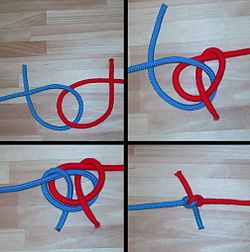(corrected jamming property description) |
|||
| (One intermediate revision by the same user not shown) | |||
| Line 1: | Line 1: | ||
[[Image:Hunters Bend HowTo.jpg|right|thumb|200px|hunter's bend step by step]] | [[Image:Hunters Bend HowTo.jpg|right|thumb|200px|hunter's bend step by step]] | ||
| − | '''Hunter's bend''', also known as '''rigger's [[Bend knot|bend]]''', is a knot used to secure two lines. It consists of 2 interlocking [[overhand knot]]s. The [[knot]] can jam | + | '''Hunter's bend''', also known as '''rigger's [[Bend knot|bend]]''', is a knot used to secure two lines. It consists of 2 interlocking [[overhand knot]]s. The [[knot]] can jam under even moderate strain. |
| + | |||
| + | Hunter's bend is one of the most recent knots to be discovered. Named after Mr. Hunter, a British man who used it for years to tie broken shoelaces before discovering its originality through a friend in the 1970s, when it made national TV news. | ||
Revision as of 16:34, 17 May 2006
Hunter's bend, also known as rigger's bend, is a knot used to secure two lines. It consists of 2 interlocking overhand knots. The knot can jam under even moderate strain.
Hunter's bend is one of the most recent knots to be discovered. Named after Mr. Hunter, a British man who used it for years to tie broken shoelaces before discovering its originality through a friend in the 1970s, when it made national TV news.

